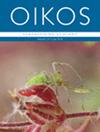The importance of biotic interactions in distribution models of wild bees depends on the type of ecological relations, spatial scale and range
IF 3
2区 环境科学与生态学
Q2 ECOLOGY
引用次数: 0
Abstract
Studies have found that biotic information can play an important role in shaping the distribution of species even at large scales. However, results from species distribution models are not always consistent among studies and the underlying factors that influence the importance of biotic information to distribution models, are unclear. We studied wild bees and plants, and cleptoparasite bees and their hosts in the Netherlands to evaluate how the inclusion of their biotic interactions affects the performance of species distribution models. We assessed model performance through spatial block cross‐validation and by comparing models with interactions to models where the interacting species was randomized. Finally, we evaluated how, 1) spatial resolution, 2) taxonomic rank (genus or species), 3) degree of specialization, 4) distribution of the biotic factor, 5) bee body size and 6) type of biotic interaction, affect the importance of biotic interactions in shaping the distribution of wild bee species using generalized linear models (GLMs). We found that the models of wild bees improved when the biotic factor was included. The model performance improved the most for parasitic bees. Spatial resolution, taxonomic rank, distribution range of the biotic factor and degree of specialization of the modelled species all influenced the importance of the biotic interaction to the models. We encourage researchers to include biotic interactions in species distribution models, especially for specialized species and when the biotic factor has a limited distribution range. However, before adding the biotic factor we suggest considering different spatial resolutions and taxonomic ranks of the biotic factor. We recommend using single species or genus data as a biotic factor in the models of specialist species and for the generalist species, we recommend using an approximate measure of interactions, such as flower richness.生物相互作用在野生蜜蜂分布模型中的重要性取决于生态关系的类型、空间尺度和范围
研究发现,即使在大尺度上,生物信息也能在影响物种分布方面发挥重要作用。然而,不同研究中物种分布模型的结果并不总是一致的,影响生物信息对物种分布模型重要性的潜在因素也不清楚。我们研究了荷兰的野生蜜蜂与植物、裂腹小蜂及其寄主,以评估纳入它们之间的生物相互作用会如何影响物种分布模型的性能。我们通过空间块交叉验证评估了模型的性能,并将有相互作用的模型与相互作用物种随机化的模型进行了比较。最后,我们利用广义线性模型(GLMs)评估了:1)空间分辨率;2)分类等级(属或种);3)专业化程度;4)生物因素的分布;5)蜜蜂体型;6)生物交互作用类型如何影响生物交互作用在形成野生蜜蜂物种分布中的重要性。我们发现,加入生物因素后,野生蜜蜂的模型得到了改善。寄生蜂的模型性能改善最大。空间分辨率、分类等级、生物因素的分布范围以及建模物种的专业化程度都会影响生物相互作用对模型的重要性。我们鼓励研究人员在物种分布模型中加入生物交互作用,特别是对于特化物种和生物因子分布范围有限的物种。不过,在加入生物因素之前,我们建议考虑生物因素的不同空间分辨率和分类等级。我们建议在专门物种的模型中使用单种或单属数据作为生物因子,而对于普通物种,我们建议使用近似的相互作用度量,如花卉丰富度。
本文章由计算机程序翻译,如有差异,请以英文原文为准。
求助全文
约1分钟内获得全文
求助全文
来源期刊

Oikos
环境科学-生态学
CiteScore
6.20
自引率
5.90%
发文量
152
审稿时长
6-12 weeks
期刊介绍:
Oikos publishes original and innovative research on all aspects of ecology, defined as organism-environment interactions at various spatiotemporal scales, so including macroecology and evolutionary ecology. Emphasis is on theoretical and empirical work aimed at generalization and synthesis across taxa, systems and ecological disciplines. Papers can contribute to new developments in ecology by reporting novel theory or critical empirical results, and "synthesis" can include developing new theory, tests of general hypotheses, or bringing together established or emerging areas of ecology. Confirming or extending the established literature, by for example showing results that are novel for a new taxon, or purely applied research, is given low priority.
 求助内容:
求助内容: 应助结果提醒方式:
应助结果提醒方式:


